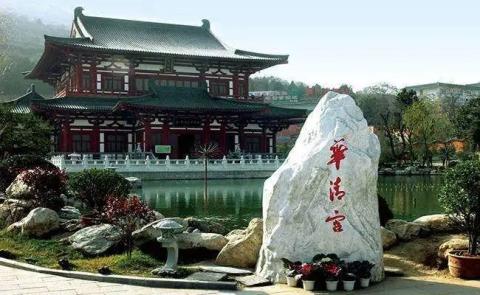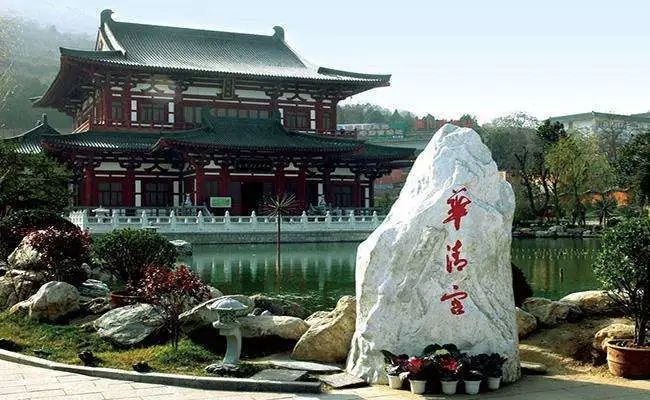
One of the Huaqing Palace Tours: Huanyuan
On the afternoon of the seventh day of the Lunar New Year in 2018, my family and I went to Huaqing Palace together. Because there was not much time left, we could only take a quick tour. Compared with the high ticket price of 150 yuan purchased by foreign tourists at the main entrance, tourists from Shaanxi can purchase tickets for 30 yuan at a small gate with their ID cards , and then go in directly. This time, we unexpectedly enjoyed the benefits of Shaanxi tourists.

After entering the door, turning to the left, I came to a courtyard. It was still winter at that time, and everything was yellow. The style and building materials of this courtyard gave people a simple and heavy feeling. My intuition told me that this was a historical site, not a modern imitation building. Sure enough, this is the famous Huanyuan.
Huanyuan was once a posthouse in the Qing Dynasty, but was destroyed by war during the Tongzhi period. During the Guangxu period, Shen Jiazhen, the magistrate of Lintong County, used the "work-for-relief" approach to rebuild the hot spring posthouse and rename it "Huanyuan". Walking in the ring garden, I saw an ancient lotus pond. To the south of the pond is the Lotus Pavilion, and to the east of the pond is the White Lotus Pavilion. When I walked to the pavilion in front of the pavilion, I found that there were many tourists watching at the door. Where are they? I looked up and saw the plaque - "The place where Chiang Kai-shek traveled". The long and narrow room is filled with simple camp beds, wooden sofas, desks and chairs. When I turned around, I found that the opposite side was also crowded with people. When I looked up, I saw "Yang Fei Chi". I squeezed to the door and looked inside. It was a small bathroom with a stone bath in the shape of a plum blossom. There was a step down from the bath. Colorful flowers and leaves were painted on the bottom of the bath, and a wooden bath stool was set up. Towels were placed at the bottom of the pool. There is an old-fashioned dressing mirror and a wooden cabinet standing next to the pool. The furnishings are very old, probably to imitate the shape of the time. There is also a rest room connected to the bathroom.

The ring garden was built in the Qing Dynasty, and the indoor soup pool is modeled after the imperial concubine's pool in the Tang Dynasty. Walking along the west bank of the lotus pond to the back of the Lotus Pavilion is the famous Five Rooms Hall. The five-room hall is a brick-and-wood structure. It is adjacent to Lishan Mountain in the south and lotus pond in the north. The courtyard is flat and it is named after the five single-room halls are connected. Tongyinxuan, also called Sanjian Hall, is adjacent to Wujian Hall. It was built in 1900 and was once the place where dignitaries stayed when visiting. In 1703, Kangxi visited Huanyuan during his western tour. In 1900, the Eight-Power Allied Forces captured Beijing. Cixi and Guangxu fled west twice and lived here and bathed here. Before the Xi'an Incident in 1936, Chiang Kai-shek stayed in the five halls here twice and used this as a bathing place. In 1957, Mei Lanfang came here to visit and bathe, and inscribed the words "Yang Fei Chi".

Walking in front of the five halls, there were a lot of tourists. In front of one wall, a father said seriously to his son: "Look here, what happened here has changed the destiny of the entire China." I couldn't help but admire this father. He was talking about the "Xi'an Incident" that happened on December 12, 1936. Two generals, Zhang Xueliang and Yang Hucheng, once persuaded Chiang Kai-shek here to abandon the civil war policy and unite the Red Army to resist Japan, but Chiang Kai-shek refused.
At 5 o'clock on December 12, Zhang Xueliang and Yang Hucheng jointly launched a military remonstrance. Chiang Kai-shek heard gunshots in his dormitory, jumped out of the bedroom window, broke his back, hid behind a big rock, and was found alive. On December 25, 1936, under the leadership of the Central Committee of the Communist Party of China and Zhou Enlai, the Xi'an Incident was peacefully resolved with Chiang Kai-shek accepting the proposition of "stopping the civil war and uniting with the Communist Party to resist Japan." The glass windows and walls of the five halls still retain bullet marks from the fierce fighting during the Xi'an Incident. Each room is now restored to its original appearance. In 1982, Wujianting, the site of the Xi'an Incident, was listed as the second batch of key cultural relics protection units in China.

After walking through the five halls, climbing the mountain according to the guide map, and passing through the mountain road with unknown turns, we arrived at the "Bingjian Pavilion". This stone pavilion was the place where Chiang Kai-shek was captured. It was built to commemorate the Xi'an Incident. The cliffs around the pavilion are covered with inscriptions of national justice. By the time we arrived at Bingjian Pavilion, the sun had already set in the west. Lishan Mountain Scenic Area is very large. It would still be some distance to reach the next scenic spot if we continue up the road. Since we couldn’t finish the tour, we simply went down the mountain to see Furong Garden and Jiulong Lake. There are The charming story of Tang Xuanzong and Yang Yuhuan...

